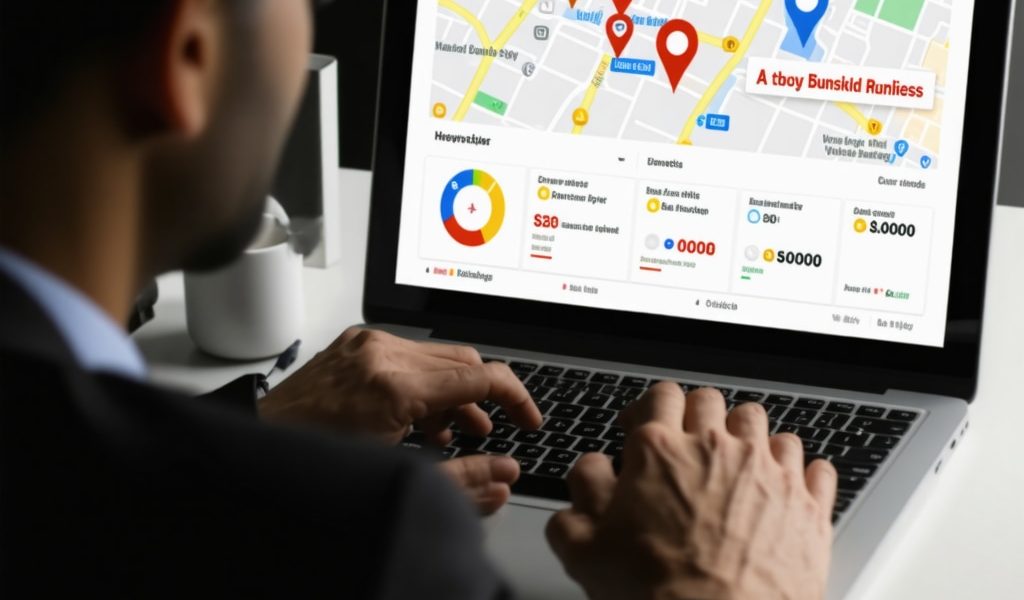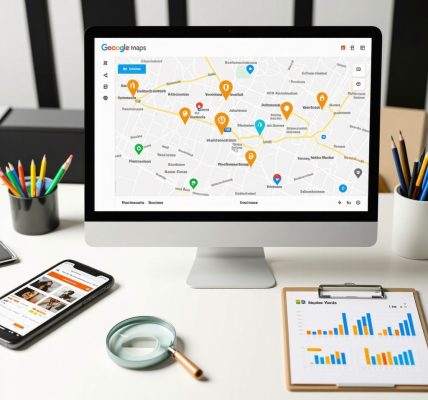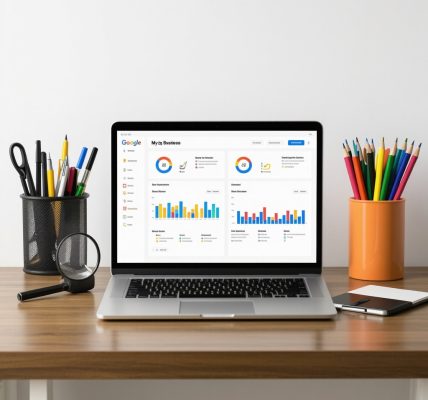Unlocking the Power of Strategic Keywords for Your Google Business Profile
In the fiercely competitive landscape of local search, mastering a Google Business keyword strategy is no longer optional—it’s essential for driving meaningful local leads. Businesses that leverage targeted, well-researched keywords within their Google Business Profile (formerly Google My Business) can significantly improve local visibility, attract qualified customers, and ultimately increase foot traffic or inquiries.
But how do you craft a keyword strategy that truly resonates with local intent and outshines competitors? This guide dives into expert insights and practical approaches that elevate your profile’s search performance while aligning with Google’s evolving algorithmic preferences.
Crafting Hyperlocal Keywords: The Secret Sauce to Local Lead Generation
Generic keywords can attract traffic, but hyperlocal keywords convert. Incorporate neighborhood names, landmarks, or even colloquial terms your target audience uses. For example, instead of just “plumber,” use “emergency plumber in Downtown Seattle” or “eco-friendly plumber near Pike Place Market.” This specificity taps into local search intent, dramatically increasing the likelihood of leads who are ready to engage.
Leverage Google’s Keyword Planner or tools like Moz Local to identify these nuanced phrases. Remember, local searchers often include “near me” or specific locations, so integrating these naturally within your business description and services can yield superior results.
Optimizing Your Google Business Description with Intent-Driven Keywords
Your Google Business description is prime real estate for embedding keywords that drive local engagement. Avoid keyword stuffing; instead, weave them contextually into compelling, benefit-oriented sentences. Describe what sets your business apart, the services you offer, and the specific local areas you serve.
For instance, a dental clinic might say, “Providing expert dental care to families in the Brooklyn Heights and Williamsburg neighborhoods, specializing in cosmetic and emergency dentistry.” This approach not only improves SEO but also enhances user trust by clearly communicating your local expertise.
How can businesses balance keyword usage without compromising readability and authenticity?
Balancing keyword integration with a natural tone requires understanding your audience’s language and search behavior. Prioritize clarity and helpfulness over sheer keyword quantity. Use synonyms, related terms, and local colloquialisms to diversify your content naturally. Test your descriptions by reading aloud and ensuring they sound conversational and inviting.
Moreover, Google’s algorithms increasingly favor content that demonstrates expertise and authenticity, so your keyword strategy should support, not undermine, these qualities.
Leveraging Google Posts and Q&A Sections for Strategic Keyword Placement
Google Posts and the Q&A section on your Business Profile are often overlooked goldmines for keyword optimization. Regularly publishing posts that address local events, promotions, or services with targeted keywords can boost your profile’s freshness and relevance.
Similarly, proactively answering common local questions using keywords strengthens your profile’s topical authority. For example, a cafe might answer, “Do you offer gluten-free options in Midtown Manhattan?” with a keyword-rich, informative response.
Building Authority with Local Citations and Backlinks
While keywords elevate your profile’s relevance, authority signals like local citations and backlinks amplify trustworthiness. Ensure your Name, Address, and Phone Number (NAP) consistency across reputable directories. Engage in citation management to correct discrepancies and build quality backlinks from local blogs, chambers of commerce, or news outlets.
Such strategies complement your keyword efforts by reinforcing your business’s legitimacy in local search ecosystems.
Want to deepen your understanding of optimizing Google Business Profiles for maximum impact? Explore our comprehensive guide on Mastering Google Business SEO to unlock advanced tactics.
For further authoritative insights, consider Google’s official documentation on Google Business Profile optimization, which provides foundational best practices directly from the source.
Engage with this content by sharing your experiences or questions below to foster a community of local SEO excellence!
Why Consistent NAP Is Your Local SEO Backbone
Reflecting on my journey optimizing Google Business Profiles, I’ve realized that consistency in your business’s Name, Address, and Phone number (NAP) across all online platforms is absolutely foundational. One time, I worked with a client whose Google Business listing had a slightly different phone number format than the one on local directories. This seemingly minor inconsistency confused Google’s algorithm and diluted their ranking potential.
Ensuring that your NAP is perfectly uniform not only helps Google trust your business but also simplifies the customer journey. Imagine a potential customer who finds two different phone numbers or addresses for your business — it instantly reduces credibility and may lead them to competitors. To keep things organized, I recommend regularly auditing your citations and using tools like Moz Local or BrightLocal to track NAP consistency and fix any errors.
How Do You Choose Keywords That Reflect Real Customer Intent?
This is a question I ask myself often because keyword research can sometimes feel like guessing. What I’ve learned is that the best keywords come from understanding your customers’ actual questions and needs. Instead of focusing only on high-volume terms, dig deeper into transactional and local-specific queries.
For example, a landscaping company might discover through customer interviews that many prospects search for “affordable lawn care services in North Austin” rather than just “lawn care.” Incorporating these phrases into your Google Business Profile description, posts, and FAQs creates a much stronger connection with search intent — and that’s exactly what Google rewards.
According to a Search Engine Journal article, Google increasingly prioritizes local intent and user satisfaction signals, so tailoring your keywords with the customer’s perspective in mind is critical for ranking success.
Using Visual Content to Enhance Keyword Relevance and Engagement
Another insight I’ve embraced is the power of photo optimization. When I started adding descriptive file names and alt texts rich with local keywords to my Google Business photos, the engagement metrics improved noticeably. Images showing your storefront, team, or products tagged with keywords like “handcrafted furniture shop in Portland” help reinforce your business’s relevance and authenticity.
Google’s algorithms analyze these signals to better understand your business context, which can positively impact your local ranking. Remember, the goal is to create a multi-dimensional profile that speaks to both algorithms and human visitors.
Have you experimented with integrating local keywords into your Google Business photos or posts? What results did you notice?
Sharing your experiences or challenges in the comments can be a great way to learn from each other and refine your strategies. You might also find inspiration in our comprehensive guide to mastering Google Business SEO, which covers these tactics in more detail.
Feel free to explore related resources like effective GMB ranking strategies or expert Google Maps SEO tactics for a holistic approach to boosting your local presence.
Elevating Local SEO by Harnessing Semantic Keyword Clustering and Searcher Behavior
To truly excel in the competitive arena of Google Business Profile optimization, it’s imperative to move beyond isolated keywords and embrace semantic keyword clustering. Semantic clustering groups related keywords and phrases that share a common search intent or topic, enabling your profile to capture a broader spectrum of relevant queries. This approach aligns with Google’s sophisticated natural language processing capabilities, which prioritize context and user intent over mere keyword matching.
For example, a boutique hotel in San Francisco might cluster keywords such as “luxury boutique hotel in San Francisco,” “romantic stays near Union Square,” and “pet-friendly accommodations SOMA district.” By strategically embedding these clusters into your business description, services, and posts, you create a rich topical map that boosts your profile’s authority and relevance.
But how do you identify effective semantic clusters that truly resonate with local audiences? Utilizing tools like Google’s Search Console to analyze search queries and user behavior data is invaluable. This data reveals the actual language and nuances your potential customers use, allowing you to refine clusters with precision.
How can semantic keyword clusters improve Google Business Profile rankings compared to traditional keyword strategies?
Semantic clusters enhance rankings by providing comprehensive topical coverage that matches a variety of user intents, reducing bounce rates and increasing engagement. Unlike traditional strategies that focus narrowly on high-volume keywords, semantic clustering captures long-tail and conversational queries, which increasingly dominate voice and mobile searches. This holistic approach signals to Google that your business is an authoritative and relevant answer hub for local searchers.
Moreover, integrating behavioral data—such as click-through rates and time spent on your profile—helps optimize which clusters to emphasize, creating a feedback loop that continuously improves your SEO performance.
Integrating Behavioral Analytics and User Interaction Signals into Keyword Refinement
Modern local SEO is not just about keyword selection but also about understanding how users interact with your Google Business Profile. Behavioral analytics tools reveal patterns in how searchers engage with your profile elements—whether they view photos, read descriptions, or click on call-to-action buttons.
By correlating these interactions with keyword performance data, you can dynamically adjust your keyword strategy. For instance, if a particular service description containing certain keywords yields higher engagement, prioritize those keywords in your posts and FAQs. Conversely, keywords that attract clicks but not conversions may signal a mismatch in intent, necessitating refinement.
Additionally, leveraging Google’s Insights tab within the Business Profile dashboard provides direct access to user search terms, enabling continuous keyword optimization grounded in real-world search behavior.
Advanced Citation Management: Leveraging Structured Data and Local Schema Markup for Keyword Synergy
While consistent NAP citations remain foundational, integrating structured data and local schema markup elevates your local SEO game by explicitly communicating your business details and keyword relevance to search engines. Schema markup allows you to embed rich metadata about your services, locations, hours, and even promotional offers, all contextualized with targeted keywords.
This granular data enhances your Google Business Profile’s ability to appear in rich results, such as knowledge panels and local packs, which command higher user attention and trust. Implementing JSON-LD schema with precise local keywords ensures that your profile not only ranks higher but also presents information in a more compelling, interactive format.
For a thorough technical guide on implementing local schema, refer to the Google Developers’ official documentation on Local Business structured data.
Multimedia Content Optimization: Beyond Photos to Video and Virtual Tours for Keyword Amplification
Expanding beyond static images, incorporating optimized video content and virtual tours into your Google Business Profile can dramatically enhance keyword relevance and user engagement. Videos titled and tagged with local keywords (e.g., “best Italian restaurant tour in Little Italy”) boost semantic richness and dwell time, key ranking factors.
Virtual tours, especially when embedded with keyword-rich descriptions, create immersive experiences that resonate with both users and search algorithms. These interactive elements reinforce your business’s local presence and authenticity, encouraging higher conversion rates.
Experimenting with these multimedia assets, while monitoring their impact via Google Analytics and Business Profile Insights, can yield significant competitive advantages.
Interested in mastering these advanced tactics? Dive deeper into our expert resources and case studies to transform your Google Business Profile into a local search powerhouse.
Deepening Local SEO with Contextual Semantic Networks
Moving beyond mere keyword clusters, developing robust contextual semantic networks around your Google Business Profile helps create a web of interconnected terms and concepts that mirror real user language patterns. This advanced semantic architecture enriches your profile’s topical authority, positioning your business as an indispensable local resource across varied search intents.
By integrating related entities, synonyms, and user-centric phrases that connect logically, your profile can capture nuanced search queries that traditional keyword strategies often miss. This approach aligns with Google’s BERT and MUM updates, which increasingly prioritize understanding the context and relationships between words.
Harnessing Behavioral Signals to Refine and Prioritize Keyword Themes
Behavioral analytics are invaluable for discerning which keyword themes truly resonate with your audience. Beyond click-through rates, metrics like interaction depth, repeat visits, and conversion pathways reveal the qualitative impact of your keyword choices. By systematically analyzing these signals, you can adjust your content and keyword focus to maximize engagement and ROI.
For example, if users consistently interact with posts centered on “sustainable landscaping services in Austin,” reallocating keyword emphasis toward this niche can amplify your local relevance and competitive edge.
What are the most effective methods to integrate behavioral data into ongoing keyword optimization for Google Business Profiles?
Effective methods include leveraging Google Business Profile Insights to monitor search queries and user actions, setting up UTM parameters for tracking traffic sources, and employing heatmaps or session recordings to observe user engagement patterns. These data points guide iterative refinements of keyword strategy, ensuring alignment with evolving user intent and business objectives.
Elevating Visibility Through Enhanced Local Schema Implementations
Implementing advanced local schema markup, such as Service, Offer, and Event schemas, enriched with semantically relevant keywords, provides search engines with explicit contextual clues. This not only improves the richness of your search results but also unlocks eligibility for enhanced features like rich snippets and knowledge panels.
According to the Google Developers’ Local Business structured data guidelines, precise schema implementation can significantly influence how your business data is parsed and presented, directly impacting local SEO efficacy.
Advanced Multimedia Keyword Optimization: Crafting Immersive Experiences
Video content and virtual tours, when meticulously optimized with localized, intent-driven keywords in titles, descriptions, transcripts, and metadata, foster deeper engagement and elevate semantic relevance. These rich media assets cater to diverse user preferences and signal comprehensive topical coverage to search engines.
Embedding localized keywords within virtual tour hotspots or video chapters creates layered touchpoints that extend keyword visibility beyond text, enhancing your profile’s dynamic appeal.

How can immersive multimedia experiences directly influence Google Business Profile rankings and user conversion rates?
Immersive multimedia experiences increase dwell time, reduce bounce rates, and enhance user satisfaction—all critical ranking factors. They provide tangible proof of your business value, building trust and prompting stronger calls to action. Enhanced engagement metrics feed back into Google’s ranking algorithms, fostering improved visibility and higher conversion potential.
Invitation to Elevate Your Local SEO Mastery
Embracing these advanced strategies—semantic networks, behavioral analytics, sophisticated schema, and immersive multimedia optimization—empowers your Google Business Profile to transcend conventional keyword tactics. Begin integrating these insights today to unlock unparalleled local search prominence.
Engage with our expert community by sharing your experiences or exploring our detailed resources to refine your approach further.
Frequently Asked Questions (FAQ)
What are hyperlocal keywords, and why are they important for Google Business Profiles?
Hyperlocal keywords are highly specific search terms that include neighborhood names, landmarks, or local colloquialisms alongside your core service keywords. They are crucial because they match the precise intent of local searchers, increasing the chance of attracting ready-to-engage customers. For example, using “emergency plumber in Downtown Seattle” rather than just “plumber” targets a specific audience and location, enhancing local relevance and conversions.
How can I balance keyword optimization with maintaining a natural and authentic business description?
To strike this balance, prioritize writing for your audience rather than search engines. Integrate keywords contextually within clear, benefit-focused sentences without overstuffing. Use synonyms and related phrases to diversify language and read your content aloud to ensure it sounds conversational. Google’s algorithms value authenticity and expertise, so your description should reflect genuine communication while subtly incorporating relevant keywords.
What role do Google Posts and Q&A sections play in keyword strategy?
Google Posts and Q&A sections serve as dynamic platforms to insert fresh, targeted keywords tied to local events, promotions, or common customer inquiries. Regularly updating these sections with keyword-rich, helpful content boosts your profile’s topical authority and signals ongoing relevance to Google’s algorithms, improving your local search visibility.
Why is NAP consistency critical for local SEO, and how can I maintain it?
NAP consistency (Name, Address, Phone Number) across all online directories and platforms builds trust with search engines and users alike. Inconsistent NAP information can confuse algorithms and diminish ranking potential. Maintain consistency by auditing your citations regularly using tools like Moz Local or BrightLocal, promptly correcting discrepancies, and standardizing formats across listings.
How do semantic keyword clusters enhance Google Business Profile rankings compared to traditional keywords?
Semantic keyword clusters group related terms that share user intent, enabling your profile to address a broader range of relevant queries. This approach aligns with Google’s natural language understanding, capturing long-tail and conversational searches often missed by isolated keywords. It improves engagement and signals comprehensive topical authority, ultimately boosting rankings.
What behavioral analytics should I monitor to refine my keyword strategy?
Key behavioral metrics include user search queries from Google Business Profile Insights, engagement rates with profile elements (such as photos, posts, and call-to-action buttons), click-through rates, time spent on profile pages, and conversion data. Analyzing these patterns helps identify which keywords resonate best and guides timely adjustments to your content and keyword focus.
How can structured data and local schema markup improve my Google Business Profile’s SEO?
Structured data and schema markup provide explicit metadata about your business services, location, offers, and events, enriched with local keywords. This helps search engines better interpret and display your profile in rich results, such as knowledge panels and local packs, enhancing visibility and click-through rates. Proper implementation increases your chances of appearing in premium SERP features.
In what ways do multimedia elements like videos and virtual tours impact keyword relevance and user engagement?
Multimedia content optimized with local, intent-driven keywords increases semantic richness and keeps users engaged longer. Videos and virtual tours create immersive experiences that reinforce your business’s authenticity and local presence. Higher user engagement metrics from these assets positively influence Google’s ranking algorithms and boost conversion rates.
How can I identify keywords that truly reflect my customers’ real search intent?
Combine direct customer feedback, local search trend analysis, and data from tools like Google Search Console and Keyword Planner. Focus on transactional and location-specific queries your audience actually uses, rather than only high-volume generic terms. This customer-centric approach ensures your keywords resonate authentically and improve lead quality.
What ongoing practices can help sustain and improve my Google Business Profile’s keyword effectiveness?
Regularly monitor analytics to track keyword performance, update your profile with fresh, locally relevant content, maintain citation consistency, and adapt your strategy based on evolving search behaviors and algorithm updates. Engaging with community feedback and leveraging advanced tactics like semantic networks and schema markup also help sustain long-term SEO success.
Trusted External Sources
- Google Business Profile Help Center (support.google.com/business/answer/7091): Official guidelines and best practices from Google for optimizing your Business Profile, including keyword usage and content policies.
- Google Developers – Local Business Structured Data (developers.google.com/search/docs/appearance/structured-data/local-business): Comprehensive technical resource on implementing schema markup to enhance local SEO and rich result eligibility.
- Search Engine Journal (searchenginejournal.com/google-business-profile-optimization): Industry-leading publication offering in-depth analysis and actionable strategies on Google Business Profile keyword optimization and local SEO trends.
- Moz Local (moz.com/products/local): A trusted tool for citation management and NAP consistency auditing, essential for maintaining local SEO authority.
- BrightLocal (brightlocal.com): Offers extensive local SEO analytics and reporting tools, including behavioral insights that support ongoing keyword strategy refinement.
Conclusion
Optimizing your Google Business Profile with a sophisticated, intent-driven keyword strategy is foundational to achieving superior local search visibility and lead generation. From crafting hyperlocal keywords and semantic clusters to leveraging behavioral analytics and implementing advanced schema markup, each tactic contributes to creating a rich, authoritative, and user-centric profile. Integrating multimedia assets further amplifies engagement, while consistent NAP citations reinforce trustworthiness.
As Google’s algorithms evolve to prioritize context, user intent, and authenticity, adopting these expert strategies ensures your business remains competitive and discoverable in local search landscapes. Start applying these insights today to transform your Google Business Profile into a dynamic local search powerhouse.
Engage with this article by sharing your experiences, asking questions, or exploring our related expert content to deepen your mastery of local SEO excellence.



This post really underscores the importance of hyperlocal keywords and how they can dramatically increase the relevance of your Google Business Profile. I’ve personally seen better engagement when I started incorporating local landmarks and colloquial terms into my descriptions and posts. It makes the profile more relatable and signals to Google that we’re deeply embedded in the community. I’m curious, how do others balance the use of local keywords without making the content sound forced or unnatural? Does anyone have tips for maintaining authenticity while still optimizing for search? Also, I found the section on multimedia content intriguing—adding videos and virtual tours has been a game-changer for my business, especially in engaging visitors more effectively. Would love to hear about your experiences with multimedia and how it impacted your local SEO performance. Thanks for such a practical and in-depth guide, it’s definitely given me new ideas to refine my strategy!